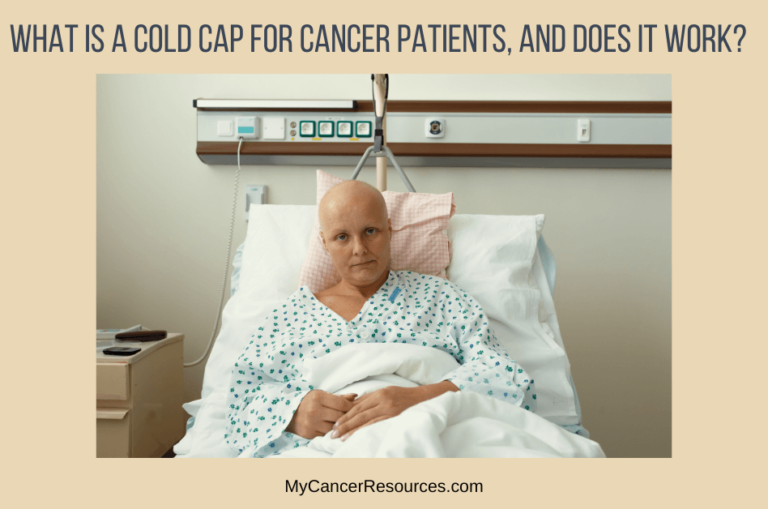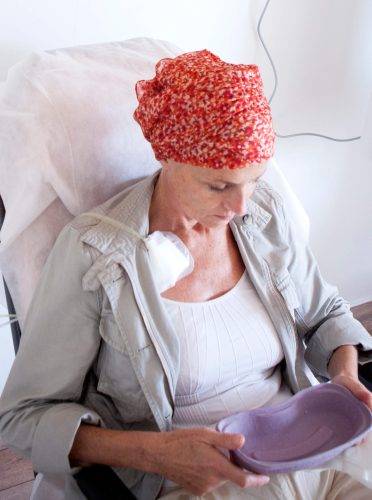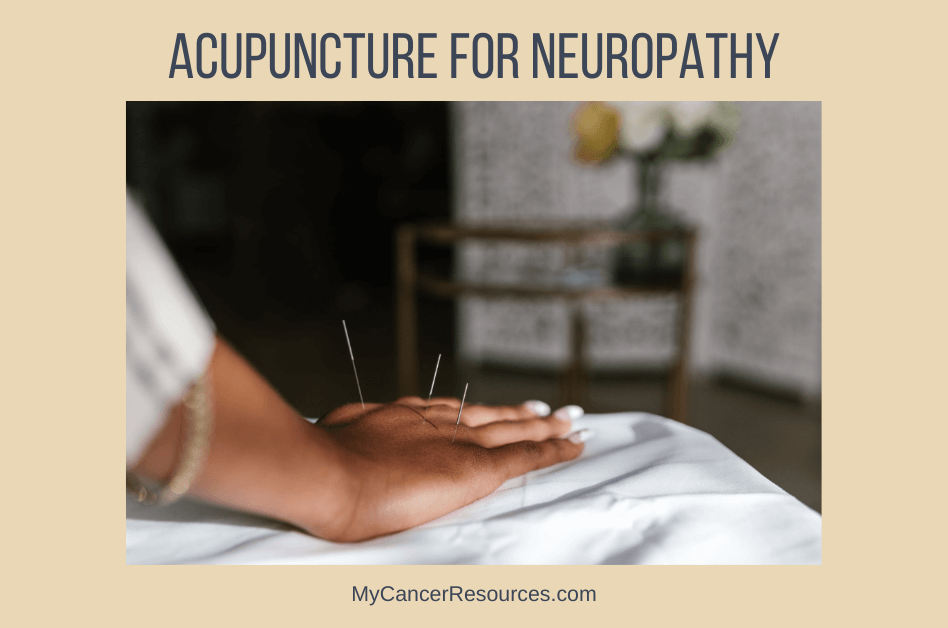
A question I’m frequently asked after someone’s cancer diagnosis is ‘will I lose my hair?’ This is understandable – one of the most distressing side effects of treatment for many is losing their hair.
Of course, I can’t guarantee whether someone will lose a little, a lot, or no hair if they’re receiving chemotherapy.
There are certain chemo drugs that are more likely to cause hair loss, but there are other factors at play as well – how much hair they have to begin with, how many rounds of chemotherapy they will have, how frequent their treatment cycles are, etc.
I do share that there are some options that can help reduce hair loss during chemotherapy: cold caps or scalp cooling systems. So what is a cold cap for cancer patients? This post explores just that.
Some people aren’t bothered by the thought of or the actual losing of their hair.
Others are slightly affected, but would rather decide on their own terms how and when the hair will be gone and opt to shave their heads before treatment begins.
Even others rock brightly colored wigs, scarves and other head coverings to bring some color into what can be a really dreary time in their life.
Some want to maintain their physical appearance as much as possible to keep some sense of normalcy throughout their cancer journey.
What’s important to remember is that you get to decide how to respond, and no decision is right or wrong – you decide what’s best for you.
For those that want to try to preserve as much hair as possible, an option to consider is to use a cool cap or scalp cooling system. Both use a snug-fitting cap that is infused with cold liquid that sends signals to your body to protect your hair follicles in the hopes that fewer hairs will fall out as a result of chemo drugs.
Why Does Chemo Make You Lose Hair?
Before getting into how scalp cooling can help people with cancer, it’s important to understand why cancer treatment can make you lose your hair.
Chemotherapy treatment is designed to seek out and destroy cells in your body that are rapidly dividing (they grow fast, quickly splitting into more cells). Cancer cells divide and multiply quickly, so it’s important to have medicine that can help stop this process.
Unfortunately, there are other cells in your body that also grow fast. Some of these include the cells in the lining of your mouth, throat and digestive tract.
Your hair cells do too, and not just the hair on your head – your eyebrows, eyelashes, body hair and pubic hair can all be affected.
As a result of fast growing cells being targeted by chemo, some of the most common side effects of chemotherapy include mouth sores, nausea and vomiting, and chemotherapy-induced hair loss. Chemo treatment wasn’t designed to attack these types of cells specifically, they’re just unfortunate bystanders also affected by the drugs.
The Mechanics of Cold Cap Therapy
The purpose of scalp cooling is to send a signal to the blood vessels beneath the scalp to constrict, or narrow. This means that the blood flow to those hair follicles (tiny pockets that hold your hair in the skin is really reduced.
The benefit of this reduced blood flow is that less chemotherapy medication that’s given during an infusion actually makes it to those hair follicles. Since less chemo is delivered to those cells, the thought is that it protects the hair cells from being damaged and fall out.
How Does a Cold Cap for Cancer Patients Work?
Cold capping can either be done manually or using a computer-controlled system.
Your scalp will need to be kept at the same cooled temperature before, during and after a chemo session.
Manual Cold Capping
With manual cold capping, you’ll have a number of tight fitting, helmet-like caps that will be stored on dry ice to keep them all frozen. You’ll bring all of your caps in a cooler to your infusion location.
You’ll need someone to come to the infusion center with you and help you switch out the cap about every 30 minutes before it thaws too much. This helps to make sure your scalp always remains at a cold temperature.
Machine-based Cold Capping
These systems use a cold cap that is hooked up to a computer. You can rent a single cap like the Paxman Scalp Cooling System. You’ll bring this to every treatment session and nursing staff will hook it up to a system that is stored at the facility.
Once the cap is secured on your head, the machine continuously circulates cold fluid throughout the cap to keep the temperature of the scalp constantly cold.
The Effectiveness of Cold Cap Therapy
Not everyone has the same results with cold cap therapy. It is estimated to work anywhere from 10-100% of the time, which is a really big range.
There are so many factors at play, it’s hard to know how successful cold capping would be for you. The success of scalp hypothermia depends on the type of cancer you have, the type of chemotherapy regimen that you’re on, the amount of chemotherapy drug or drugs you receive, and how well you tolerate the cold.
An additional factor that can affect success rates is your hair type. Hairs that lay flat against the scalp tend to have better results because the special cap must be snug against your scalp to be most effective.
Who Shouldn't Use Cold Cap Therapy?
If any of these apply to you, scalp cooling is not recommended:
- Blood cancers
- Skin cancers
- Central Nervous System (CNS) tumors
- Sensitivity to cold temperatures
- Have had or plan to have radiation to the head
Dignicap is another scalp cooling company, and they have a longer list of conditions and situations that should not use scalp cooling.
Drawbacks to a Cold Cap for Cancer Patients
While there are certainly benefits to cold capping, there are also some drawbacks. In some studies, up to 50% of participants stopped using their cold cap.
The most common side effects of cold capping can include:
- Reduced body temperature – I always remind clients that you’ll get cold while using cold caps! Wear layers, take a comfy blanket and use the heated blankets available to you at your infusion clinic.
- Discomfort or pain in head, neck and shoulders
- Scalp pain similar to a brain freeze type of feeling
Other drawbacks include needing to have someone come with you and stay for your whole session, including up to a few hours afterward to switch out the manual cooling caps. The nursing staff will not be able to do this for you. So you’d have to make sure you had someone able and willing to come with you each time for the entire time, as cold capping must be done consistently for best results.
Last but not least, the cost of cold capping can be expensive. If you opt for manual cold caps, there’s the cost to rent or purchase them and also buy dry ice for each chemo session to keep them cold. Scalp cooling systems can also be expensive to rent, but you do save money not having to buy dry ice or ice packs each time.
While some insurance companies are getting better at approving scalp cooling, not all do. You’ll have to ask your insurance company if it’s covered, or if it’s an approved expense by flexible spending accounts.
Is a Cold Cap Right For You?
Talk to your medical oncologist about your planned treatment program, and if the medicines are expected to make you lose your hair.
If you are a candidate for scalp cooling, decide how important it is to you to try to reduce the severity of hair loss.
You may decide that the discomfort and potential inconvenience of staying for each treatment session longer is a small price to pay to maintain as much of a normal life as possible.
Your turn: Have you tried cold cap therapy? If so, please share in the comments below your experience and what, if anything, do you wish you would have known before you started?



